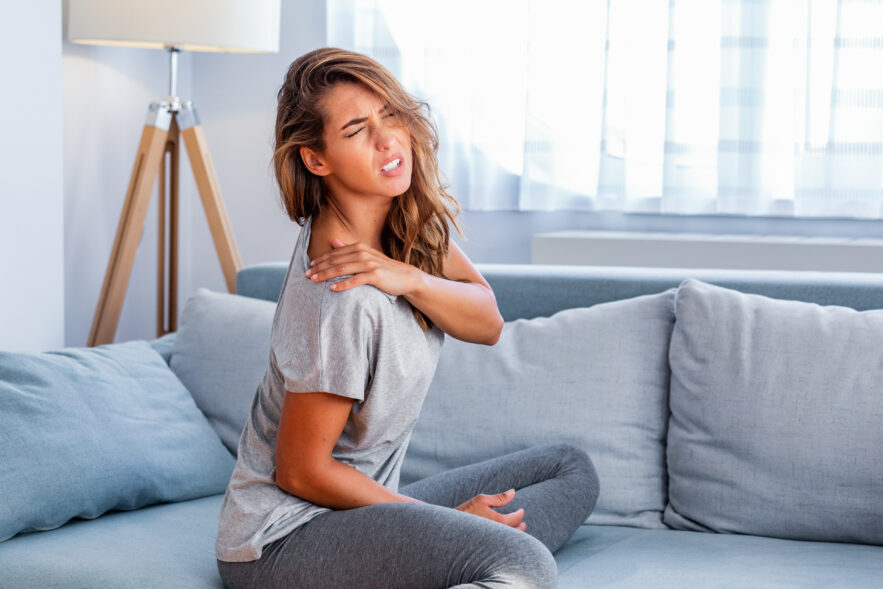Prevent the Need for Pain Medications with These Helpful Tips
If you have any pain, discomfort or imbalances in your body, there is a chance that your sitting habits are playing a big factor. Think about it. Most people are sitting between nine and 14 hours a day.
With all that sitting can come tight hips, neck and shoulder tension, and, of course back pain! With that nagging discomfort you may find your focus is often leaving your work, thus lowering your overall productivity. It seems like there is an obvious answer: you should stop sitting so much, right? But what if you can’t?! Most of us are required to work in a sitting position most days.
Use the following tips to save your body some pain and improve your working productivity.
Browse This Article
1. Be in a good position before you sit down.
Just like when you are squatting in the gym, it’s a heck of a lot easier to keep good form from the start, versus trying to get into good form at the bottom of a squat. Before you sit down, stand with good posture. As you are sitting down, hip hinge (sitting the hips back like you are trying to touch the wall behind you with your butt) into a seat and keep your back straight. As you can see, gym tactics can be used in real, daily situations.
2. Sit on the edge of your chair.
When you sit all the way back on your chair, your hamstrings start to take on the brunt of your weight. We do not want that. Not only will sitting on your actual “sit bones” help prevent your hamstrings from getting stiff, but it will also help prevent moving your femur into an unwanted position of the hip socket. Scoot forward in your seat to ease pain.

3. Sit on a hard surface.
Though it may feel nice and comfy when you sit on something soft, like a couch cushion, it is much less stable and sturdy of a surface. Because of this, it makes it more difficult to maintain our position.
What usually happens is the tailbone tucks under, resulting in a flexed lumbar position, which leads to more rounding of your back, as well. Alternatively, a hard surface gives us that sturdiness we need to maintain our positioning.
As you can see in the picture below, I went into the seat with good form, but instantly rounded my back when I put all my weight into the cushion.
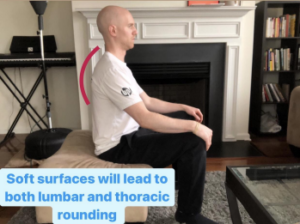
4. The higher the seat, the better your posture.
The higher up we sit, the closer it is to a standing position. This means the less hip flexion we incur. Less hip flexion leads to less hip and quad tightness, which leads to less of a “Donald Duck butt” when standing. It is a vicious chain reaction!
See the previous two pictures to see the difference in hip angle. The lower your hips sink into a seat, the more tension they will feel.
5. If you do sit back, use a lumbar support.
For the times when you do not have a choice and have to sit all the way back, say in the car or on an airplane when you are belted in, use lumbar support. Most chairs encourage a flexed (rounded) lumbar spine. To change this form, roll up a towel and place it in between the chair and your lower back.
Make the cushioning thick enough to give you just a bit of that natural lumbar curve. There are also products made specifically for this. A simple Google search for something like, “lumbar support,” will provide you with many options. You can also check out the Back Fit Pro website here for more supportive products to assist your posture. Some options here are a little bit pricier than others you will find, but they make some of the best products around, in my opinion.
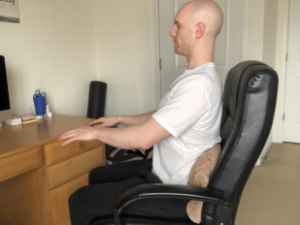
6. Recline back.
This goes by the same logic as sitting in a higher up position. If we are not able to be at the edge of our seat, we may be able to recline back. This position makes it so, not only is the degree between thigh and pelvis greater, but it takes less work to maintain good posture in your back. However, while in this position, just make sure you are not reclined back so far that you have to reach your head and neck forward to do something.
7. Change positions frequently.
It doesn’t really matter whether we are sitting or standing, if we stay in the same position for too long, we will probably end up with an achy back. Whether it’s every 5, 10, or 20 minutes, try to change your sitting position. Check out some of the pics below to see some ways to switch it up, while still staying seated. Of course some of these only apply to specific types of chairs, so find positions that work best for you. And yes, some do look a little ridiculous, but they are an option nonetheless.



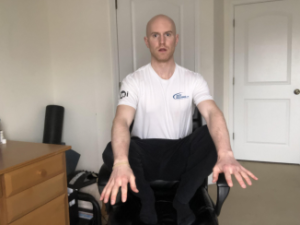
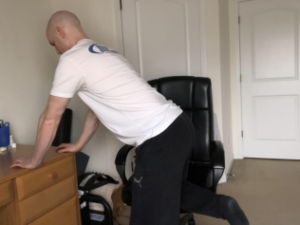
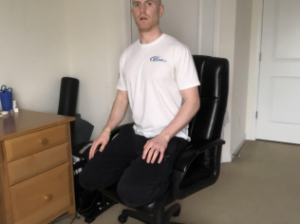
8. Get up and move frequently.
Finally, even if you are doing everything in your seat perfectly, you should still keep the body moving. That doesn’t mean carrying a dumbbell around with you to curl 24/7, but it does mean if you have a desk job, take a two to five minute break every 30 to 60 minutes to get up and stretch or walk around.
If you have a job where you are constantly on your feet, find somewhere to lay or sit down instead. There are some good mobility flows you can find to do in those breaks (I post plenty on the Healthy Movement Blueprint social media pages). In the end, I just want you to move, however you choose to do so.
You Can Do It!
Now, before you start thinking about how you cannot manage to do half of these, stop! Do what you can. Maybe you are able to do the first two at your office job, but not at your kitchen table. Maybe you can do the next two in the kitchen, but not at work. Try to take advantage of whichever ones you can, where you can.
If you are in pain now, there is no better time to make some changes. If you are not in pain, but live life with poor posture, there is also no better time to make some changes.
Boomer Perrault is the founder of Healthy Movement Blueprint. You can find more information via his social media tag @HealthyMovementBlueprint.
Healthy lifestyle changes can help you avoid medications and their side effects. To avoid unnecessary risks, MedShadow Foundation brings you research-based, unbiased wellness content to provide you with alternatives to help you, and those you love, reduce or eliminate your need for medications. All of our work is done free from pharmaceutical influence or funding.


